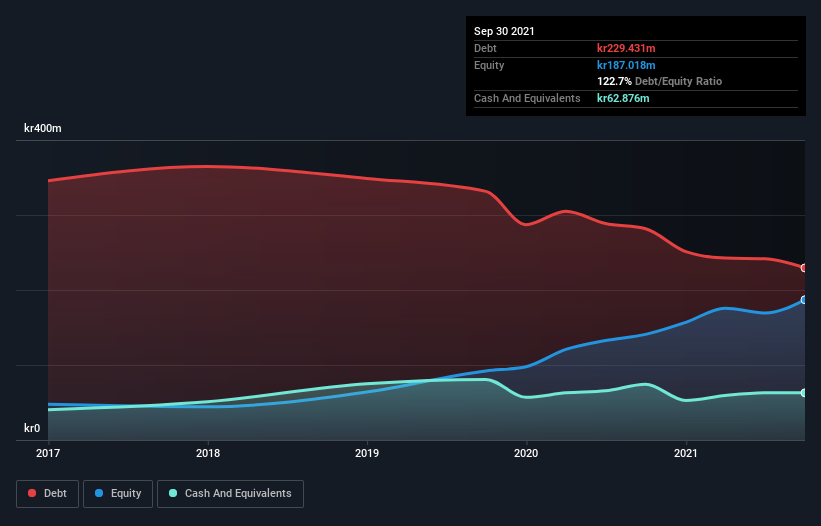- Sweden
- /
- Commercial Services
- /
- OM:QAIR
These 4 Measures Indicate That QleanAir (STO:QAIR) Is Using Debt Reasonably Well

Warren Buffett famously said, 'Volatility is far from synonymous with risk.' It's only natural to consider a company's balance sheet when you examine how risky it is, since debt is often involved when a business collapses. As with many other companies QleanAir AB (STO:QAIR) makes use of debt. But should shareholders be worried about its use of debt?
When Is Debt A Problem?
Debt and other liabilities become risky for a business when it cannot easily fulfill those obligations, either with free cash flow or by raising capital at an attractive price. Ultimately, if the company can't fulfill its legal obligations to repay debt, shareholders could walk away with nothing. While that is not too common, we often do see indebted companies permanently diluting shareholders because lenders force them to raise capital at a distressed price. Of course, the upside of debt is that it often represents cheap capital, especially when it replaces dilution in a company with the ability to reinvest at high rates of return. When we examine debt levels, we first consider both cash and debt levels, together.
See our latest analysis for QleanAir
What Is QleanAir's Net Debt?
The image below, which you can click on for greater detail, shows that QleanAir had debt of kr229.4m at the end of September 2021, a reduction from kr281.7m over a year. However, it also had kr62.9m in cash, and so its net debt is kr166.6m.

How Strong Is QleanAir's Balance Sheet?
The latest balance sheet data shows that QleanAir had liabilities of kr202.5m due within a year, and liabilities of kr217.2m falling due after that. Offsetting this, it had kr62.9m in cash and kr44.8m in receivables that were due within 12 months. So its liabilities outweigh the sum of its cash and (near-term) receivables by kr312.1m.
While this might seem like a lot, it is not so bad since QleanAir has a market capitalization of kr799.4m, and so it could probably strengthen its balance sheet by raising capital if it needed to. However, it is still worthwhile taking a close look at its ability to pay off debt.
We use two main ratios to inform us about debt levels relative to earnings. The first is net debt divided by earnings before interest, tax, depreciation, and amortization (EBITDA), while the second is how many times its earnings before interest and tax (EBIT) covers its interest expense (or its interest cover, for short). This way, we consider both the absolute quantum of the debt, as well as the interest rates paid on it.
With a debt to EBITDA ratio of 1.7, QleanAir uses debt artfully but responsibly. And the fact that its trailing twelve months of EBIT was 8.2 times its interest expenses harmonizes with that theme. QleanAir grew its EBIT by 6.5% in the last year. That's far from incredible but it is a good thing, when it comes to paying off debt. The balance sheet is clearly the area to focus on when you are analysing debt. But it is future earnings, more than anything, that will determine QleanAir's ability to maintain a healthy balance sheet going forward. So if you want to see what the professionals think, you might find this free report on analyst profit forecasts to be interesting.
Finally, a business needs free cash flow to pay off debt; accounting profits just don't cut it. So we always check how much of that EBIT is translated into free cash flow. Over the last three years, QleanAir recorded free cash flow worth a fulsome 81% of its EBIT, which is stronger than we'd usually expect. That positions it well to pay down debt if desirable to do so.
Our View
Happily, QleanAir's impressive conversion of EBIT to free cash flow implies it has the upper hand on its debt. And its interest cover is good too. All these things considered, it appears that QleanAir can comfortably handle its current debt levels. On the plus side, this leverage can boost shareholder returns, but the potential downside is more risk of loss, so it's worth monitoring the balance sheet. When analysing debt levels, the balance sheet is the obvious place to start. But ultimately, every company can contain risks that exist outside of the balance sheet. To that end, you should be aware of the 4 warning signs we've spotted with QleanAir .
If you're interested in investing in businesses that can grow profits without the burden of debt, then check out this free list of growing businesses that have net cash on the balance sheet.
Valuation is complex, but we're here to simplify it.
Discover if QleanAir might be undervalued or overvalued with our detailed analysis, featuring fair value estimates, potential risks, dividends, insider trades, and its financial condition.
Access Free AnalysisHave feedback on this article? Concerned about the content? Get in touch with us directly. Alternatively, email editorial-team (at) simplywallst.com.
This article by Simply Wall St is general in nature. We provide commentary based on historical data and analyst forecasts only using an unbiased methodology and our articles are not intended to be financial advice. It does not constitute a recommendation to buy or sell any stock, and does not take account of your objectives, or your financial situation. We aim to bring you long-term focused analysis driven by fundamental data. Note that our analysis may not factor in the latest price-sensitive company announcements or qualitative material. Simply Wall St has no position in any stocks mentioned.
About OM:QAIR
QleanAir
Engages in the provision of air cleaning solutions for professional and public indoor environments in Sweden and internationally.
High growth potential with solid track record.


